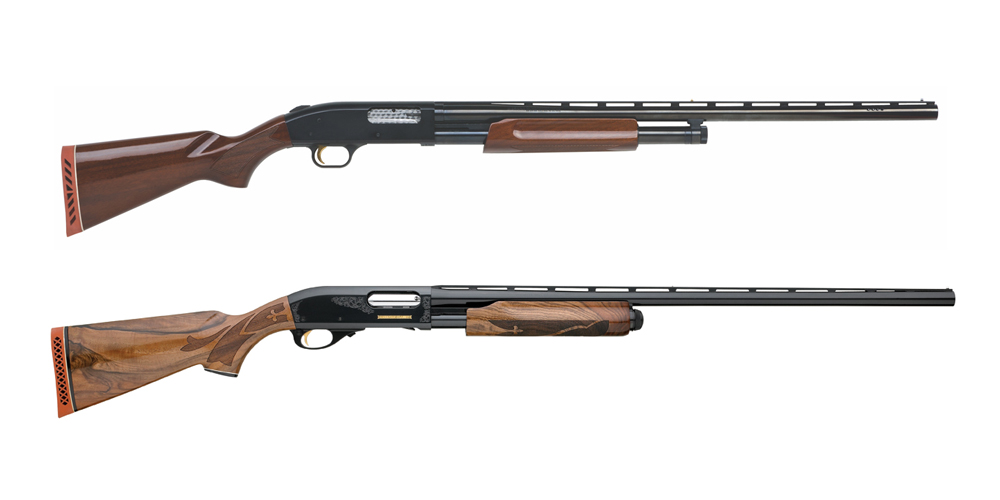At GunDigest, we independently review products. However, we may earn a commission when you purchase through links on our site. Learn More
Face-Off: Mossberg 500 vs. Remington 870


There are iPhones users, and there are Android users. Proponents of one rarely cross over to the other. It’s the same with Remington’s 870 and Mossberg’s 500. Even though both shotguns are quite similar, there are differences, differences that are favored by some over others.
The Model 500 and Model 870 are both legendary, each being produced in the tens of millions, and still counting. Not bad for two designs that were developed in the early 1950s (Remington) and early 1960s (Mossberg) in a time when telephones had cords and a dial. It is hard to argue which is the most popular.
The 870 and 500 are safe, adaptable, proven in the field, the streets and in combat. Originally designed for sporting use, theses pump-action shotguns have been adapted to tactical, LE and defensive applications. Models range from hunting and competition to tactical and home defense. As home defense weapons, the 500 and 870 are both natural fits.
Being pump-action or slide-action shotguns, they are safer to use because the actions are manually operated. The pump in the pump action ejects a fired shell and chambers a fresh round via manipulation of the forend. Some may debate the intimidation factor of the sound of a pump gun on someone who has come to do you or your family harm, but at least it provides confidence to the home defender and tells the intruder in no uncertain terms to get out now while you can.
Shotguns like the 870 and 500 are unique defense weapons since they offer multiple options that range from serious prodding to tremendous violence. Less-lethal loads with rubber balls or plastic sabots can take care of a hungry spring black bear raiding your bird feeder and hopefully give it a clue to scamper away. Firing 00 buck essentially unleashes nine pellets—similar to shooting a target nine times with a 9mm pistol at once. Slugs offer long-range defense with accuracy that rivals some rifle cartridges.
The complexity of shotguns comes in learning to feed the tube. Shotguns have a limited magazine capacity and need to be constantly refilled. Changing over from a 00 buck or less-lethal load to a slug with shells in the magazine tube takes training—training that may mean the difference when running a shotgun in defensive situations.
First, the similarities. Both the Mossberg and Remington were designed for use with interchangeable barrels. Loosen and/or remove the magazine cap (Remington) or loosen the magazine nut (Mossberg), pull off the barrel and replace it with another. They both use dual-action bars for a smoother and more reliable pump action. The bolt of both shotguns also locks in the rear of the barrel and does not use the receiver. Both feed off a tubular magazine that can be plugged to abide hunting laws or removed to have extra round capacity for home defense. They also disassemble in a similar fashion, and the trigger group of both are easily removed for cleaning by removing either two (Remington) or one (Mossberg) trigger housing pin(s). They both are available in 12 or 20 gauge, good options for home defense. In 12-gauge options, they both accept 2¾- and 3-inch shells.
Now, how about the differences? The Mossberg Model 500 features an ambidextrous safety located at the top of the receiver where a shooter’s thumb naturally rests when firing the 500. The aluminum receiver makes the 500 lighter. The Flex TLS System variant changes the playing field with regard to the versatility of a pump shotgun. Users can quickly—within seconds—re-configure the 500 for hunting or tactical and back again without any tools. So a traditional stock can be replaced with a pistol grip, or a traditional fore-end can be swapped for one with a tactical light. Depending on the model, the magazine capacity is 6+1 or 8+1.
The Remington Model 870 uses a steel receiver, which makes it a bit heavier, which is not necessarily a bad thing in a home defense shotgun. More mass means less felt recoil. The safety is located behind the trigger in the rear of the trigger guard and favors right-handed shooters. The action bar lock is located on the left side of the trigger guard just forward of the trigger. The Model 870 has an edge in power with Express models that accept larger 3½-inch shells for greater payload, power and range. Magazine capacity is 4+1 or 6+1 depending on the model.
The final similarity with the 870 or 500 is the vast number of aftermarket parts that allow a home defender to customize these shotguns to better suit the user’s need to protect and defend their homeland. With either pump, you have an excellent home defense weapon.
This article is an excerpt from the March 2016 issue of Gun Digest the Magazine.
Next Step: Get your FREE Printable Target Pack
Enhance your shooting precision with our 62 MOA Targets, perfect for rifles and handguns. Crafted in collaboration with Storm Tactical for accuracy and versatility.
Subscribe to the Gun Digest email newsletter and get your downloadable target pack sent straight to your inbox. Stay updated with the latest firearms info in the industry.